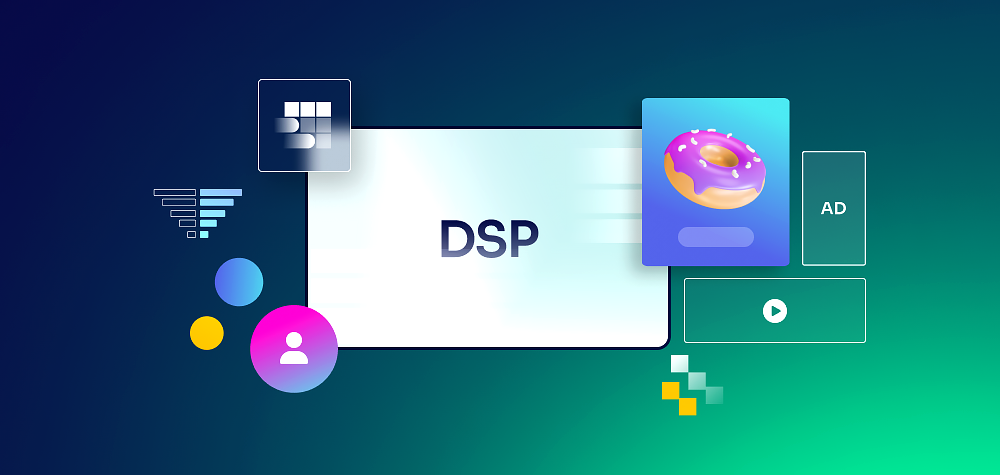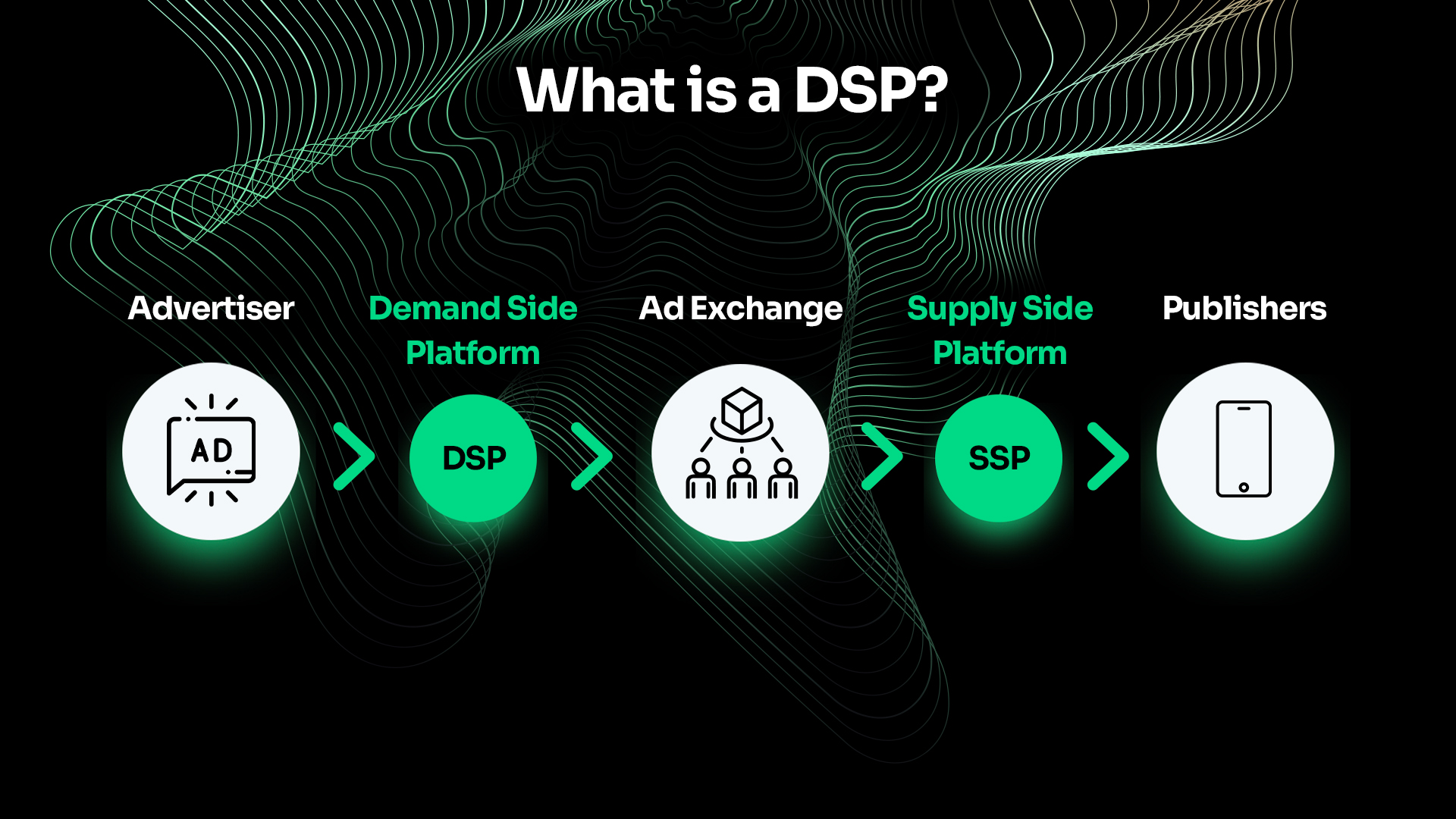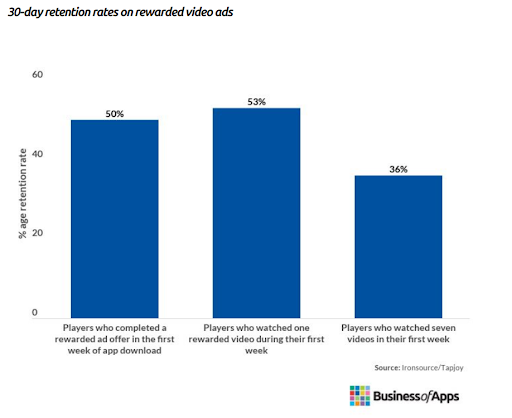The programmatic advertising system is a two-way street: advertisers who ‘demand’ ad inventory and publishers who ‘supply’ it.
For publishers in the mobile space, boosting traffic and in-app conversions is the name of the game.
For advertisers, it’s all about reaching the best target audience at the right time, with the right ad experience to encourage engagement and conversions.
While this might sound simple in a nutshell, there’s a lot of ad-tech that facilitates the process of supply and demand. On the advertising side – also known as the demand side – the Demand-Side Platform is the star of the show.
What is a Demand-Side Platform (DSP) – Understanding Programmatic Advertising
A Demand-Side Platform (DSP) is a software platform that enables advertisers to buy and manage digital ad placements across publisher sites on the web and in mobile apps. With a DSP, advertisers can operate multiple accounts on multiple ad exchanges, trade desks and SSP, via one centralized interface.
In the programmatic advertising process, advertisers and publishers interact in bidding auctions for the sale and purchase of ad inventory. Publishers ‘supply’ the ad inventory to the marketplace, and they use an SSP (Supply-Side Platform) to do so. Advertisers are the demand side of the equation, and they rely on the DSP providers to participate in these transactions.
DSP marketing, however, is much more than just auctions. By using a DSP, advertisers can connect with multiple publishers and auctions at the same time. This provides them with access to a broad pool of ad inventory and significantly expands their reach among potential audiences.
With programmatic DSP, the process of bidding for and buying ad space is automated with advanced tools to optimize audience targeting and bid pricing, so advertisers get the best ad placements at the best cost. In addition, DSPs provide campaign management and analytics capabilities, so advertisers can manage and optimize multiple campaigns far more easily and quickly than if they were simply to rely on old-fashioned manual media buying methods.
How Mobile DSP Works – The Role of Ad Tech and Real-Time Bidding
In traditional media buying, advertisers had to manually submit bids for separate auctions on all the different publications, websites or apps where they wanted their ads to appear. Ad-tech and real-time bidding changed all that.
Around a decade ago, programmatic advertising hit the scene. It enabled advertisers to automate the process of bidding in auctions for ad space across multiple publisher sites and apps, and buy the best ad placements in a split second. That’s where DSPs come into the picture.
Here’s how DSP advertising works: An advertiser creates a digital ad campaign and submits it to the DSP, defining the target audience and bid price in advance. Publisher inventory becomes available on the market via the SSP. Both sides in the programmatic auction – the DSP and SSP – ‘talk’ to each other via ad exchanges and DMPs (data management platforms). Using AI-based algorithms, the DSP identifies and places the most appropriate bids for multiple auctions at once.
All of this happens automatically in real time, when a user lands on a web page or an app. In a split second, the DSP operates on behalf of the advertiser to buy the best placements and show ads to the most relevant users at the best price.
Publisher > SSP > Ad exchange /DMP /Trade desk < DSP < Advertiser
Mobile DSP providers operate in precisely this way, but exclusively for mobile ad inventory and in-app advertising. Advertisers who want to promote their business on apps use mobile DSPs to specifically reach mobile audiences with targeted campaigns. A mobile DSP will take into account a range of mobile-specific signals to determine the best bids and target audiences. These include real time location, device and OS.
Mobile DSPs also have to take into account changing data privacy regulations specific to mobile advertising, including mobile web cookies and mobile advertising IDs, such as Apple’s IDFA and Google’s GAID.
What are the Types of Mobile DSPs?
There are several DSP platforms available to advertisers, including those that specialize in particular networks, ad types or campaign strategies. For example, using Facebook Ads Manager, advertisers can bid in real-time programmatic auctions for ad space across Meta properties. Amazon’s AAP is the DSP for advertising on all of Amazon’s sites and apps.
Mobile DSPs specialize in ad inventory across the mobile advertising ecosystem. Here are three types of mobile programmatic DSPs that advertisers can choose from:
Full-service mobile DSP
A full-service mobile DSP provides a complete media buying solution for advertisers. Led by an assigned account manager, the DSP team manages and controls ad campaigns and bidding strategies on behalf of the advertiser. With a full-service DSP network, the advertiser is in expert hands, leaving ad bidding, buying and optimization up to an outsourced team. On the other hand, this is a far more expensive option, and places most of the control with the DSP, rather than with the advertiser.
Self-serve DSP
With a self-serve DSP, advertisers manage their ad buying and optimization activities directly, via the dashboard. The self-serve setup cuts out any third-parties, thereby reducing the cost of media buying. By choosing a self-serve DSP that meets their needs, advertisers gain access to huge amounts of ad inventory, easily and efficiently.
While self-serve platforms are built for user-friendliness, they do require some skill and knowledge. Advertisers who are adept at programmatic buying can take full advantage of the built-in targeting, optimization and budget tools of the DSP to drive the best campaign performance.
White label DSP
A white label DSP is available for purchase and ready to use. The DSP platform is provided as a blank slate, so the advertiser can tweak and configure the mechanisms to create a proprietary solution that meets the needs of the business. With a white label DSP, the advertiser can integrate with the SSPs and ad exchanges of their choice, and even build specific algorithms to support their buying strategy and enable specific campaign customization capabilities.
White label DSPs are a costly investment, however, making them a viable alternative only for large agencies or companies that engage in enormous amounts of media trading.
Key Features and Benefits of Mobile DSPs
Whether self-serve, full service or white label, advertisers must engage with a DSP to bid and buy mobile ad placements in programmatic RTB auctions. Fortunately, DSPs do much more than just provide access to real-time bidding – they have several important advantages for mobile advertisers. Let’s take a look at the key features and benefits:
Ad buying in one place
A DSP is a centralized hub where advertisers can manage multiple programmatic advertising accounts and campaigns. Via the dashboard, advertisers access numerous SSPs, ad exchanges, DMPs and trade desks, making the process of campaign set up, auction bidding and optimization far more efficient. A DSP also gives advertisers much more control over their mobile ad placements and campaign spend.
Better targeting
DSP advertising supports advanced targeting capabilities, enabling advertisers to define and reach specific audience segments for different campaigns, across websites, apps and platforms.
Various parameters, such as demographics, interests and browsing behavior, can all be used to target the most relevant users. Advertisers can also leverage DSPs for retargeting and other advanced segmentation tactics, such as Likely-to-be audiences, further expanding their potential audience. Mobile DSPs typically offer mobile-centric targeting parameters, like real-time location, OS, device, and other signals, to drive meaningful ad experiences, engagement and conversions among mobile audiences. For publishers, this is key to boosting app monetization.
Engaging mobile ad formats
By using a mobile DSP network, advertisers can tap into a range of ad formats that are designed to engage and entice mobile users. For example, rewarded video ads are a powerful tool for app retention. According to one study, the retention rate for mobile gamers who watched a rewarded video ad in the first week of app use was over 50%, which is around 6X more than average app retention rates.
Source – Business of Apps
There are many more engaging ad formats for mobile, including interstitial, native and banner ads. With DSP ads, advertisers can buy these effective formats at scale, targeted to the right audiences on apps and the mobile web, boosting engagement and campaign performance.
Performance tracking and optimization
A big benefit of DSP marketing is the built-in data integrations and analytics capabilities. Advertisers can track and monitor data on impressions, clicks, conversions, and other key metrics across multiple campaigns in real time, providing valuable insights about campaign performance. Armed with these insights, advertisers can make smarter decisions about campaign optimization and drive better results over time.
Improved ROI
DSPs allow advertisers to define budget limits, bidding strategies and frequency capping rules across campaigns to ensure cost efficiency. In addition, DSPs use algorithms and machine learning methodologies to automate campaign management and optimization processes, improving ad performance in real time. All these factors come together to help advertisers achieve their KPIs more efficiently and maximize the ROI of their campaign spend.
Mobile DSP Best Practices for Effective Targeting and Optimization
While mobile DSPs offer a range of features and benefits, there are steps advertisers can take to make sure they get the most from the targeting and optimization capabilities. Here are best practices that advertisers should keep in mind:
- Make sure your campaign objectives are clear: Before launching into RTB auctions, clearly define your campaign goals and KPIs, whether it be conversions (such as app installs, completing a form) or engagement (ie. video views, clickthrough rates, etc). This is essential to determine the best targeting parameters and optimize your bidding strategy accordingly.
- Segment and test your targeting strategies: Divide your target audience into segments based on relevant criteria, such as demographics and location. Together with mobile audience data, including consumer niche, device and OS, this will help enrich your targeting strategy. Then, make sure to test and refine your targeting to become more accurate and effective over time.
- Leverage high-performance mobile ad formats: Experiment with different ad formats that can engage audiences more effectively at various touchpoints. At the same time, continually adjust your bidding strategy to focus on high-performing placements and target audience segments that show better engagement and conversions.
- Always be A/B testing: Conduct A/B tests on your DSP ads and visual messaging, including copy, headlines, CTAs and landing pages. This is necessary to identify the top-performing variations and optimize your campaigns.
- Stay in control: Make sure to work with DSP providers that offer deep analytics and reporting so you can maintain control over your mobile campaign settings. Monitor factors such as budget caps and KPI metrics to ensure that your campaign results are aligning with your objectives and budget.
What are the Main DSP Limitations?
Understanding the limitations of DSPs can help advertisers make informed decisions about their programmatic buying activities. Let’s take a look at the main issues that can arise:
- Data quality: Mobile DSPs depend on data analytics to optimize campaigns and target audiences effectively. However, data accuracy and quality can vary, directly impacting the success of mobile campaigns. In addition, MAID tracking restrictions and data privacy regulations can limit the availability and use of certain data sources.
- User experience: Mobile DSPs must balance ad delivery and the experience of the user. Advertisers should avoid overloading the target audience with intrusive or irrelevant ad experiences that negatively impact user engagement and brand perception.
- Brand safety: While DSPs provide efficient and automated media buying at scale, it is vital that advertisers keep brand safety top of mind. This means adhering to app store guidelines and policies, and working only with high-quality mobile DSPs that can guarantee brand-safe placements.
- Attribution tracking: Attribution tracking is always a challenge, and even more so in mobile environments. Other factors such as cross-device usage make attribution particularly tricky on mobile. A DSP that integrates with reliable attribution measurement partners is the best way to go.
How to Choose the Right Mobile DSP for Your Advertising Campaign
Before making a decision about which DSP platform is right for you, here are several questions you should ask:
How user friendly is it?
Firstly, ensure that the interface and dashboard are easy to use, and integrations with DMPs and other data partners are available to boost the efficacy of mobile campaigns.
Accurate audience targeting is vital, so make sure to evaluate if the mobile DSP utilizes integrated first- and third-party data to segment audiences and improve targeting algorithms.
Is it safe?
A good mobile DSP vendor will make brand safety a priority by offering high-quality traffic sources, only allowing high quality advertisers and brands, and using advanced fraud prevention tools. Explore how the platform handles fake traffic and clicks, and request details about viewability metrics that track impressions seen by real users.
How diverse is the mobile ad inventory?
To get the most from a mobile DSP, choose one that supports a wide variety of ad formats, including rich media, video, native ads, interstitials, rewarded ads and more. Also, be sure that the DSP can provide access to the publisher supply you need to reach your relevant target audiences.
What reporting options are available?
Take a look at the reporting capabilities and make sure the DSP offers granular reporting that can deliver value-added insights. Comprehensive and relevant reporting is essential for optimizing campaign performance and getting the most from your media buying process.
In answering the question ‘what is a DSP in advertising’?, you’ve taken the first step towards a more effective and high-performing mobile ad buying process. To dive deeper into the possibilities of targeted mobile ad campaigns, explore Start.io’s global network of mobile user data and advanced audience segmentation and activation options.





